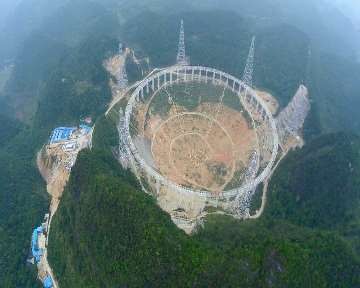China will harness Supercomputer Skyeye-1 to provide support to a radio telescope being assembled in the mountains of Guizhou Province, which has a dish the size of 30 football fields, the Xinhua News Agency reported.
The report said that the five hundred meter aperture spherical telescope (FAST) will become the world's largest radio telescope, surpassing the Arecibo Observatory in Puerto Rico, which is only 300 meters in diameter. The radio telescope is expected to be completed in 2016.
According to the report, the telescope can receive a radio signal beamed from as far as tens of billions of light years away, which is expected to extend the scope of China's space tracking from the moon's orbit to the far edges of the solar system.
In Nov. 2014, a joint agreement to build Qiannan Super Computing Center in Guizhou was signed by the Institute of Computing Technology under the Chinese Academy of Sciences (CASICT), Dawning Information Industry Co. and China (Guizhou) Skyeye Group.
The report said that the development of the Supercomputer Skyeye-1, capable of a quadrillion computing operations per second, could help support FAST, which needs strong computing system to support massive data storage and processing.
A researcher with the CASICT said that FAST will need more than 10 petabyte in its first-phase storage demand. It would have a daily peak demand of more than 200 teraflops per second during normal operation, the researcher added.
Ren Jingyang, vice president of Dawning Information Industry Co., said that Skyeye-1 can easily meet the demands of the telescope, with its quadrillion computing operations per second and high-speed network of 100 gigabytes per second.
The radio telescope's construction was started in March 2011 in a natural, bowl-shaped valley in southern Guizhou.



























